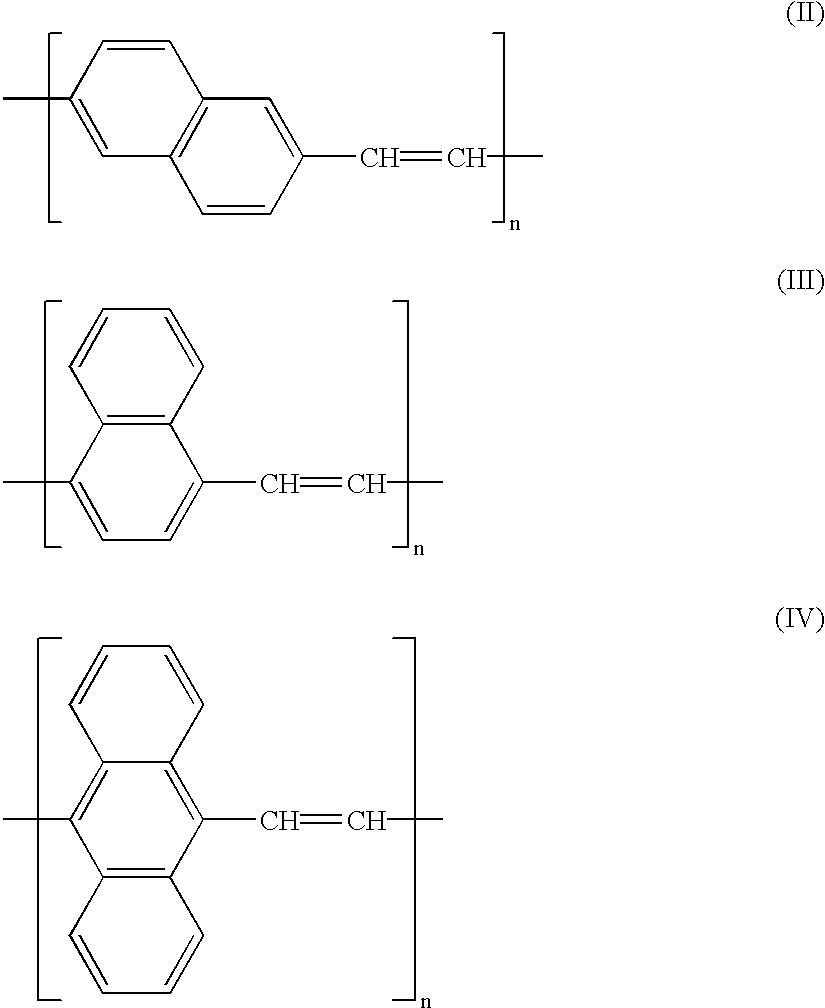Organic electroluminescent device having a conjugated polymer and an inorganic insulative electron injecting and transporting layer
a technology of electroluminescent devices and conjugated polymers, which is applied in the direction of discharge tubes/lamp details, discharge tubes luminescnet screens, other domestic articles, etc., can solve the problems of significant acceleration of the degradation of organic thin films, sensitivity to electrodes, and the formation of organic layers of organic materials
- Summary
- Abstract
- Description
- Claims
- Application Information
AI Technical Summary
Benefits of technology
Problems solved by technology
Method used
Image
Examples
example 1
A substrate of (7059) glass by Corning Glass Works was scrubbed using a neutral detergent.
By RF magnetron sputtering from a target of ITO oxide, a hole injecting electrode layer of ITO having a thickness of 200 nm was formed on the substrate at a temperature of 250.degree. C.
After its ITO electrode-bearing surface was cleaned with UV / O.sub.3, the substrate was secured by a holder for spin coating.
A methanol solution of a PPV precursor having a concentration of 1 g of polymer per 10 to 25 g of methanol was spin coated onto the substrate having the inorganic insulative hole injecting layer deposited thereon. This coating was carried out by applying the polymer solution to the entire surface of the substrate and then rotating the substrate at a revolution of up to 5,000 rpm while keeping its upper surface horizontal.
The substrate with the polymer precursor layer was heated for 12 hours in a vacuum oven at a temperature of 300.degree. C. This heat treatment converted the polymer precurs...
example 2
In Example 1, the main component, auxiliary component and stabilizer of the inorganic insulative electron injecting and transporting layer were changed from SrO to MgO, CaO or mixtures of these oxides, from Li.sub.2 O to K.sub.2 O, Rb.sub.2 O, K.sub.2 O, Na.sub.2 O, Cs.sub.2 O or mixtures of these oxides, and from SiO.sub.2 to GeO.sub.2 or oxide mixtures of SiO.sub.2 and GeO.sub.2, respectively, with substantially equivalent results. Similar results were obtained when the negative electrode forming material was changed from Al to Ag, In, Ti, Cu, Au, Mo, W, Pt, Pd, Ni or alloys thereof.
example 3
In Example 1, after its ITO electrode-bearing surface was cleaned with UV / O.sub.3, the substrate was secured by a holder in a vacuum evaporation chamber, which was evacuated to a vacuum of 1.times.10.sup.-4 Pa or lower.
Using a target of SiO.sub.2, an inorganic insulative hole injecting layer was deposited to a thickness of 2 nm. The sputtering gas used herein was a mixture of Ar and 5% of O.sub.2. Depositing conditions included a substrate temperature of 25.degree. C., a deposition rate of 1 nm / min, an operating pressure of 0.5 Pa, and an input power of 5 W / cm.sup.2. The hole injecting layer thus deposited had a composition of SiO.sub.1.9.
Thereafter, a PPV film was formed as in Example 1, and an inorganic electron injecting layer, an Al--Li (Li: 7 at %) film, and an Al film were formed, obtaining an organic EL device.
The resulting organic EL device was evaluated as in Example 1, finding substantially equivalent results.
PUM
 Login to View More
Login to View More Abstract
Description
Claims
Application Information
 Login to View More
Login to View More - R&D
- Intellectual Property
- Life Sciences
- Materials
- Tech Scout
- Unparalleled Data Quality
- Higher Quality Content
- 60% Fewer Hallucinations
Browse by: Latest US Patents, China's latest patents, Technical Efficacy Thesaurus, Application Domain, Technology Topic, Popular Technical Reports.
© 2025 PatSnap. All rights reserved.Legal|Privacy policy|Modern Slavery Act Transparency Statement|Sitemap|About US| Contact US: help@patsnap.com



